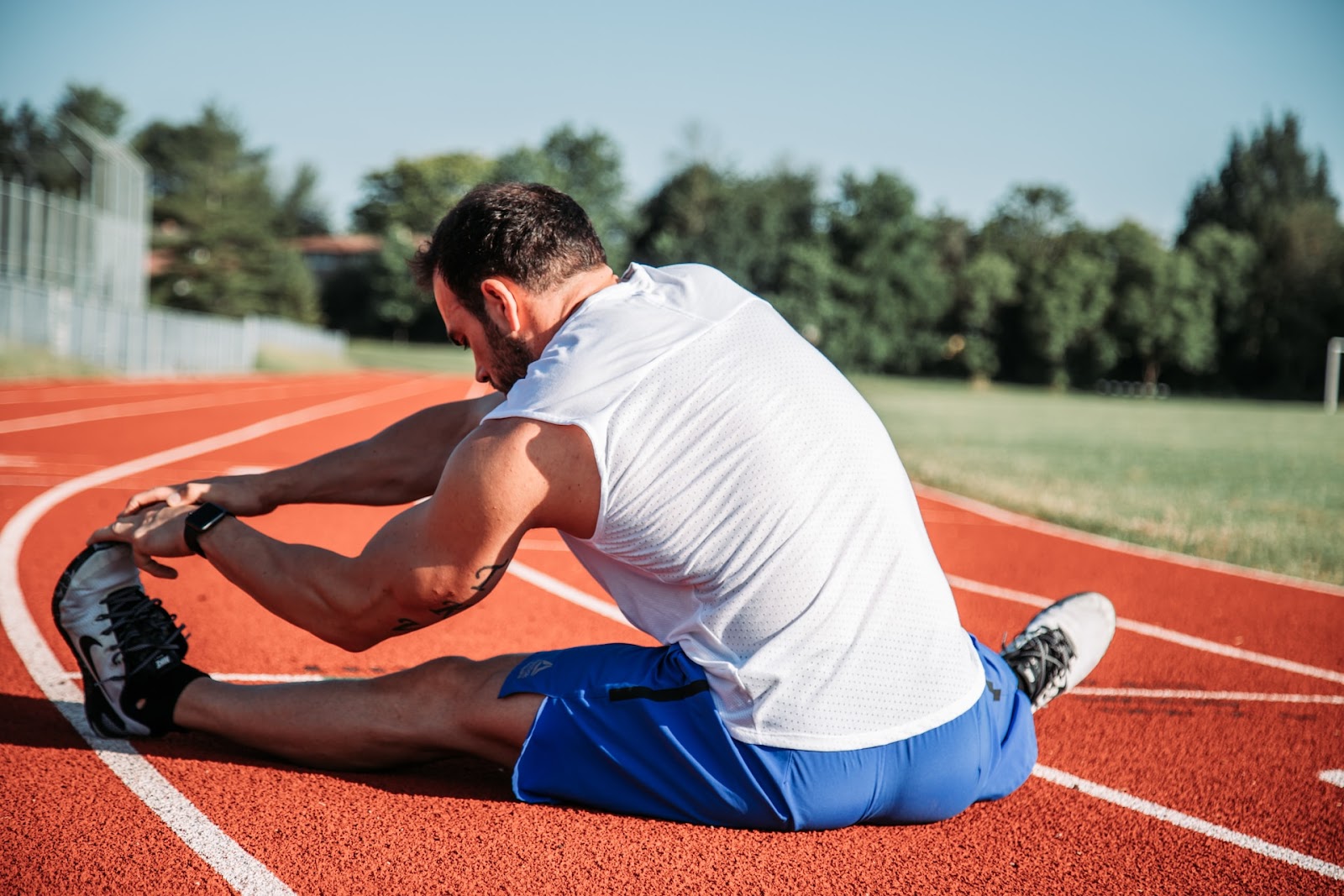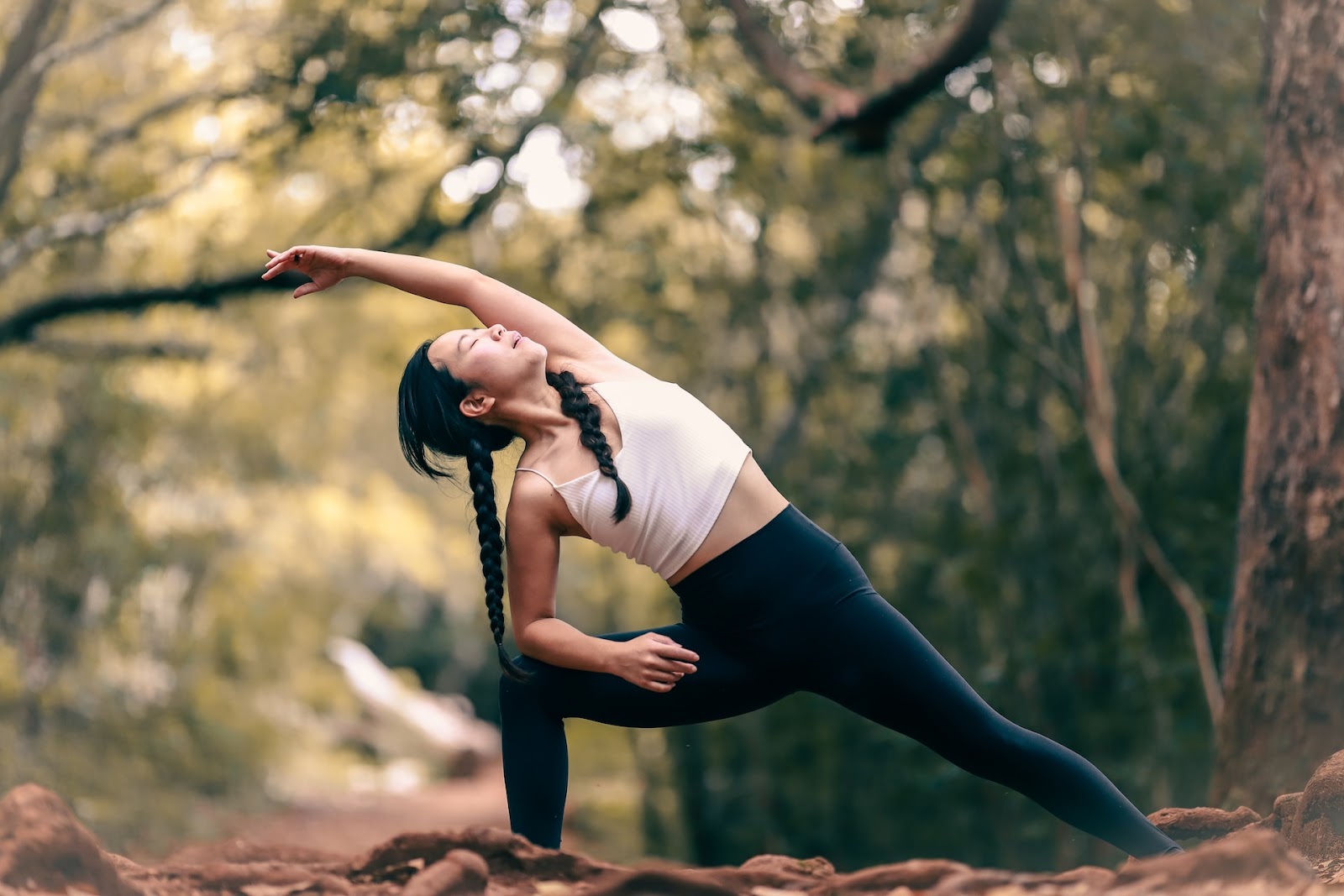The difference between static and dynamic stretching lies in their approach toward increasing flexibility and reducing the risk of injury during physical activities.
Static stretching involves holding a stretch for some time, typically between 10 to 30 seconds. This form of stretching effectively improves overall flexibility and range of motion, but it should be done after physical activities. Dynamic stretching involves continuous movement through a range of motion, often resembling actions performed during physical activities. This form of stretching is effective in improving performance, and coordination and reducing the risk of injury when done as a warm-up before physical activities.
Choosing between static and dynamic stretching depends on your goals, but utilizing both methods for optimal results is best.
Static Stretching
Static stretching is a form of stretching that involves holding a position for some time. This type of stretching is designed to relax the muscles and help improve the range of motion and flexibility. Static stretching should be performed slowly and gently without bouncing or jerking the body into the stretch. It is important to never stretch to the point of pain, as this could cause further injury.
Let’s look at dynamic stretching to see how it differs from static stretching.
Definition And Explanation of Static Stretching
Static stretching is a stretching exercise involving holding a stretch position for a certain amount of time without moving. It is different from dynamic stretching, which consists of repeatedly moving the body part through a full range of motion.
Static stretching is ideal for improving flexibility, increasing joint range of motion, and reducing muscle tension. It is also an excellent warm-up and cool-down technique for athletes, as it prepares the muscles for activity and helps prevent injury. It is essential to hold each stretch for at least 30 seconds when performing static stretching, as this allows the muscle to lengthen and relax fully. Dynamic stretching, on the other hand, is better suited for improving muscular endurance and power. It is typically used as part of a warm-up routine to prepare the body for dynamic movements.
Benefits of static stretching
Static stretching is a type of stretching that involves holding a stretch for an extended period, usually 15-60 seconds. It has numerous benefits when incorporated into your workout routine.
| Advantages of static stretching include: |
| Improved flexibility: Holding a stretch in a stationary position over time helps lengthen the muscle fibers, increasing flexibility and range of motion. |
| Reduced muscle tension: Static stretching helps reduce muscle tension by promoting relaxation, which can help alleviate soreness and prevent injuries due to overuse. |
| Improved posture: Static stretching can improve posture by reducing muscle imbalances and promoting proper alignment. |
| Reduced stress and anxiety: The slow, intentional nature of static stretching can help reduce stress and anxiety by promoting relaxation and mindfulness. |
While dynamic stretching is more suitable for pre-workout as it consists of moving through a range of motion, static stretching is great for post-workout cooldowns.
Common Static Stretching Exercises
Static stretching exercises involve holding a specific position for a set amount of time, typically to increase flexibility and range of motion.
Here are a few common static stretching exercises you can incorporate into your routine:
| Hamstring stretch: | Sit on the floor with one leg straight out and the other bent with the foot flat against the inner thigh. Reach forward and try to touch your toes, holding the stretch for 20-30 seconds. |
| Quad stretch: | Stand with one hand against a wall or chair for balance. Bend one leg back and grab the ankle with the corresponding hand, pulling it towards the buttocks until you feel a stretch in the front of the leg. Hold for 20-30 seconds and switch sides. |
| Shoulder stretch: | Interlace your fingers behind your back and straighten your arms. Lift your arms away from your body and hold for 20-30 seconds. |
Unlike dynamic stretching, which involves continuous movement, static stretching is done without movement and is best done after your workout when your muscles are warm.

Dynamic Stretching
Dynamic stretching is an integral part of anyone’s warm-up routine. It involves a series of active stretching exercises that progress in intensity to increase flexibility and range of motion. Unlike static stretching, which involves holding a stretch for a specific period, dynamic stretching focuses on flowing movements that require active engagement throughout the entire range of motion.
Let’s explore the differences and how they can improve your performance.
Definition And Explanation of Dynamic Stretching
Dynamic stretching is a type of stretching that involves moving and stretching the muscles through a full range of motion. It differs from static stretching, which involves holding a position for an extended period.
The benefits of dynamic stretching include improving flexibility, increasing blood flow, and reducing the risk of injury during physical activity. Dynamic stretching also helps to improve athletic performance by preparing the muscles for the movements that will be performed during the activity.
Examples of dynamic stretches include leg swings, arm circles, walking lunges, and high knees. These stretches use momentum and movement to increase the body’s range of motion gradually.
Unlike static stretching, which is done after physical activity, dynamic stretching is typically done before, as part of a warm-up routine. Doing so helps prepare the body for the physical activity that is about to be performed.
Benefits of Dynamic Stretching
Dynamic stretching is an effective way to warm up your muscles and prepare for physical activity by increasing your heart rate and blood flow. Unlike static stretching, which involves holding a single position for an extended period, dynamic stretching involves continuous movement and stretching through a range of motion.
Here are some of the benefits of dynamic stretching:
| Benefit | Description |
| Reduced risk of injury | Dynamic stretching helps reduce the risk of injury by increasing blood flow and mobility, allowing muscles and joints to move more freely. |
| Improved performance | Dynamic stretching prepares your body for physical activity, making it more responsive and efficient during the activity. |
| Better range of motion | Dynamic stretching helps improve flexibility and range of motion by preparing your muscles for movement and elongating muscle fibers. |
Pro tip: Incorporate dynamic stretching into your warm-up routine before physical activity to enhance your performance and reduce your risk of injury.
Common dynamic stretching exercises
Dynamic stretches are a form of stretching that involves movement and momentum to improve range of motion, coordination, and flexibility. Unlike static stretches, which involve holding a stretch in a stationary position, dynamic stretches are performed actively and challenge the muscles to work in new ways.
Here are some common dynamic stretching exercises that you can incorporate into your warm-up routine:
| Exercise | Benefits |
| Walking Lunges | Improves hip flexibility, strengthens the lower body, and engages the core muscles. |
| Butt Kicks | Performed by jogging in place and trying to kick your bottom with your heels. |
| High Knees | Similar to Butt Kicks but involve lifting your knees high. |
| Leg Swings | Swinging your legs back and forth or from side to side while holding onto a sturdy object for balance. |
These dynamic stretches should be done before the workout, and they can help you prevent injury, enhance performance, and increase flexibility. Pro tip: Remember to start with low-intensity dynamic stretches for the first few minutes of your workout and then gradually increase intensity.

Key Differences Between Static And Dynamic Stretching
Static and dynamic stretching are important parts of any warm-up or cool-down routine. The main difference between static and dynamic stretching is the type of movement used during each exercise. Static stretching involves no movement, or very minimal movement, of the muscles and joints, while dynamic stretching typically involves continuous, controlled movements.
Let’s look at the key differences between static and dynamic stretching.
Differences in Execution And Technique
Static stretching involves holding a sustained, static stretch for an extended period. In contrast, dynamic stretching involves moving through a series of stretches that mimic the movements of a particular sport or activity.
| Execution | Technique |
| Static stretching is performed slowly and gradually, with each stretch held for 10-30 seconds. Dynamic stretching is performed with more motion and movement, using a series of continuous stretches and movements that warm up the muscles without holding any one particular stretch for too long. | Static stretching involves a controlled, relaxed movement as you ease into the stretch, holding it for a set period before releasing. On the other hand, dynamic stretching involves more exaggerated movements that mimic the range of motion needed for a particular activity or sport. |
Although both types of stretching are beneficial, dynamic stretching is particularly useful for warming up muscles before exercise. In contrast, static stretching is best for cooling down muscles after exercise to prevent injury and improve flexibility.
Conditioning And Performance Benefits of Each
Static and dynamic stretching are two common stretching exercises that offer different conditioning and performance benefits.
Static Stretching: This involves holding a stretch in a fixed position for an extended period, typically around 15-30 seconds. This type of stretching is the most suitable for improving flexibility and range of motion, reducing muscle tension, and aiding relaxation. It is commonly used after exercise.
Dynamic Stretching: This involves doing a series of controlled movements that gradually increase the range of motion and speed of the body part being stretched. This form of stretching helps improve muscular endurance and coordination, warm up the body before exercise, and enhance athletic performance.
Choosing the right type of stretching exercise is critical based on your fitness goals, the activity you plan to perform, and your body’s needs. Incorporating both forms of stretching into your regular exercise routine can maximize their conditioning and performance benefits.
Risks And Considerations For Both Types of Stretching
Static and dynamic stretching are two common types of stretching exercises used to increase flexibility and reduce the risk of injury.
| Key differences between Static and Dynamic Stretching are as follows: |
| Static Stretching: This involves holding a stretch in one position for an extended period, usually around 30 seconds or more. It’s best done after a workout when the muscles are warm. Static stretching improves flexibility and range of motion, but it’s not ideal for warming up before exercise because it can decrease muscle strength and power. |
| Dynamic Stretching: This involves active movement and stretching of the muscles, usually in a specific pattern, such as leg swings, lunges or trunk rotations. It’s best done before workouts to prepare the muscles for exercise by increasing blood flow and heart rate. Dynamic stretching improves flexibility, balance, and coordination while helping to prevent injury. |
| Risk and Considerations: Static stretching can lead to overstretching, which can cause injury, especially if the muscles are not warm. Dynamic stretching can also lead to injury if done incorrectly, but it’s generally safer than static stretching. |
| Pro Tip: Incorporating both types of stretching into your exercise routine can have significant benefits. Just be sure to do every kind at the right time and in the right way. |

When to Use Static And Dynamic Stretching
Static stretching and dynamic stretching are two common stretching methods. They can both be used to improve mobility and flexibility, but they are used differently.
Static stretching is done when the body is at rest and involves holding a stretch for a period of time. Dynamic stretching is done while the body moves and consists of specific body movements.
This article will discuss the differences between static and dynamic stretching and when each should be used.
Ideal Use Cases And Recommendations For Each
Static and dynamic stretching are two types that aim to warm up the muscles before physical activity and increase flexibility. The main difference between the two is that static stretching involves holding a muscle in a stretched position for a long time. In contrast, dynamic stretching involves repeatedly moving the muscles through a range of motions.
| Type of Stretching | Ideal Use Cases | Recommendations |
| Static | After physical activity, during cool-downs, and on rest days | Improving flexibility, preventing injury, and reducing muscle soreness |
| Dynamic | Before physical activity | Improving range of motion and reducing the risk of injury |
It is important to note that incorporating both types of stretching into your routine can have numerous benefits for your overall physical health and fitness. Pro Tip: Aim to incorporate various static and dynamic stretches into your warm-up and cool-down routines to optimize performance and prevent injury.
Pre-Workout And Post-Workout Considerations
Knowing when to use static and dynamic stretching in your pre- and post-workout routines can greatly affect your fitness results.
Static stretching involves holding a stretch in one position for a set amount of time, while dynamic stretching involves repeatedly moving through a range of motion. So which one should you use before and after your workout? Before a workout, dynamic stretching is a better option as it helps to warm up your muscles and increase their range of motion, preventing injury. Static stretching is better reserved for after your workout when your muscles are already warmed up, helping to reduce soreness and improve flexibility.
Pro tips- It’s important to note that general stretching is most effective when combined with other warm-up and cool-down exercises, such as foam rolling and mobility drills. Remember to listen to your body and adjust your stretching routine accordingly.
Incorporating Both Types of Stretching Into a Well-Rounded Routine.
To create a well-rounded stretching routine, it is best to incorporate static and dynamic stretching depending on your fitness goals and activity levels. Static stretching involves holding a stretch in a fixed position for a period, whereas dynamic stretching involves repeatedly moving your body through a range of motion.
Here’s how to incorporate both types of stretching:
| Before a workout | After a workout |
| Dynamic stretching | Static stretching |
| Warm up muscles | Cool down the muscles |
| Increase flexibility and mobility | Improve flexibility |
| Prepare the body for exercise | Reduce any stiffness or soreness |
| Ideal for activities that require explosive movements, such as sprinting and jumping | Ideal for activities that require flexibility or endurance, such as yoga and long-distance running |
By incorporating both types of stretching into your routine, you increase the range of motion of your joints, reduce the risk of injury and enhance athletic performance. Pro tip: Always listen to your body and never overstretch.
